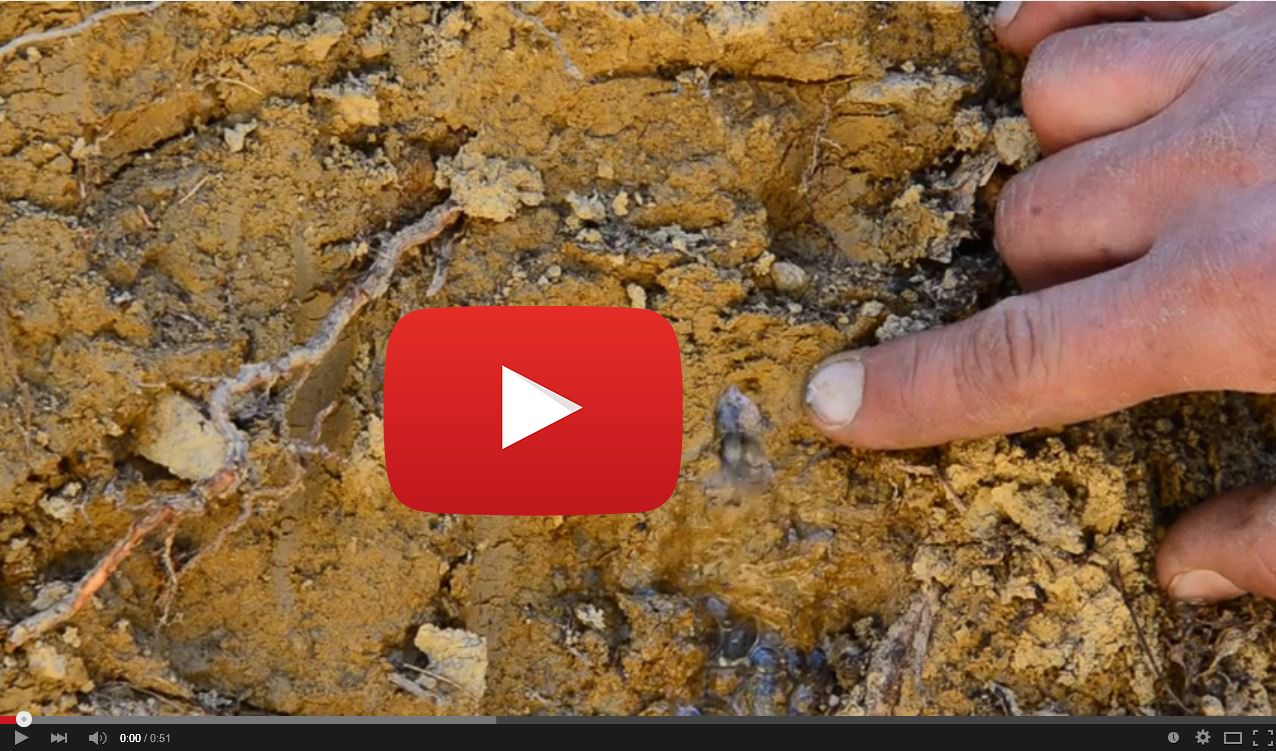

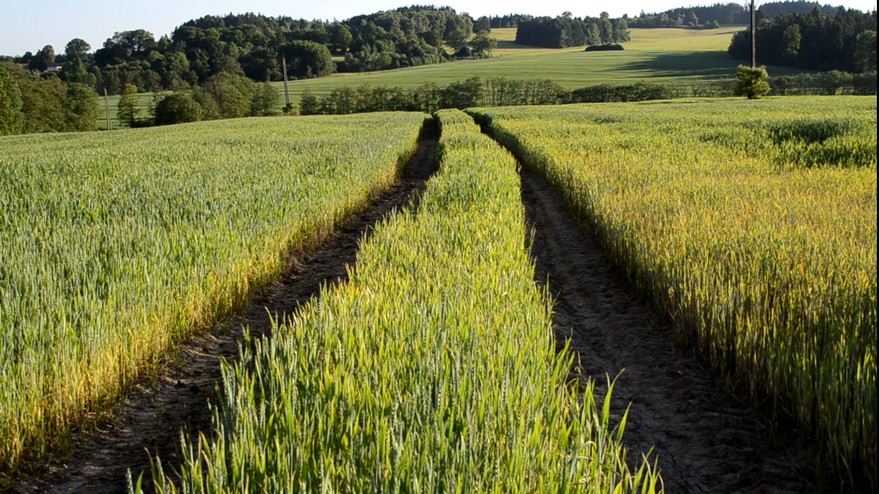
In the last 6 years, I have travelled across Europe monitoring floods in 16 countries. All of them followed the same scenario – and had the same cause. The water, which we allowed to run off quickly from the woods, is flooding populated areas; and the floods are followed by droughts.
My observations led me to one conclusion – all those countries were using the same logging and agricultural methods. And all of them were making the same mistakes!
So what are the mistakes we are all making?
1. WE ARE DRAINING LOWLAND AREAS BY LAND IMPROVEMENT MEASURES;
2. WE ARE COMPRESSING SOIL IN FORESTS AND FIELDS UNCONTROLLABLY;
3. WE ARE DISRUPTING NATURAL PROFILES OF HILLS AND CREATE MAN-MADE SLOPES.
We are doing this with staggering speed on all continents which are then heated by solar radiation. The heated land subsequently heats up Earth’s atmosphere and the cycle keeps on repeating faster and faster and with growing extremes. The biggest problem is the fact that solar radiation heats up the drained lands excessively, the air heated up by the overheated lands rises and is trapped due to greenhouse gases.
Intact soil (with pores) vs. compressed soil (squeezed pores)

In order for us to understand the entire issue better it is important to realise the following:
one cubic meter holds 200-500 litres of water

According to scientific research, one cubic meter of intact soil in Central Europe holds some 200 to 500 litres of water. Soil is thus an essential drinking water reservoir designed by nature.
Water in soil can be found in pores. It circulates through a natural branched distribution system feeding
- roots of plants;
- sources of water streams;
- groundwater reserves.
If we compress the soil, we squeeze the pores and destroy this system. The natural cycle will be lost.
Similar thing happens when we disconnect this system mechanically. Then, the natural irrigation system becomes a drainage system allowing for the irreversible runoff of water from the soil, thus draining the lands gradually.
Broken pores
In other words,
IF WE SQUEEZE THE PORES IN SOIL, WATER CANNOT BE SOAKED UP
IF WE BREAK THE PORES, WATER FLOWS OUT OF THE SOIL
Causes of fast draining of soil = causes of floods
Compressed soil in forests
Wrong agricultural methods on fields
Land improvement measures on lowland areas - draining canals
Man made slopes

Forest road – a paved road meant for wood or timber transportation by trucks
Logging track – a road used for timber hauling by horses and tractors to the forest roads
Natural rainwater retention capability of forests decreases every year due to the construction of forest roads and the uncontrollable growth of compressed areas in forests. It all started in the 1970s when heavy machinery started to be used more in forests with the aim to increase efficiency as well as profits. Since then, the speed of water runoff from forests increased significantly.
And it has been since then that climatologists started to notice faster increase in the Earth’s surface temperatures.
Recent years have brought even faster growth of compressed soil areas in forests.
We have been using wood (as splinters for heating and power plants) as a renewable source of energy more often which has led to an extreme increase of logging.
That is the second factor influencing the record-breaking heat waves in 1987.


Treetops retain rainwater in the forests. Subsequently, the water travels through leafs, branches and tree trunks into forest soil and the pores in soil transport it even to the places where there are no tree roots.
Yet there are many places in the forests that have not seen water even despite the long-term rains. Paradoxically, water often runs off from the forests along the compressed ground areas which can be found next to these dried parts of the forests.
Rainwater runoff along compressed areas
If there is an inclined forest road running along the tree line, water is discharged along the root systems, taking along the soil, which results in baring of the tree roots.
Forest owners and keepers recklessly leave the soil devastated after logging. Yet this devastated ground speeds up the discharge of water from the forests. Many countries even have laws in place stipulating that compressed soil should be restored to its original state after logging so that it is capable of retaining water again. However, this is not being done and so the compressed soil area keeps on growing.


Satellite picture, Czech Republic: http://maps.google.cz/?ll=48.846615,14.027503&spn=0.005218,0.009645&t=h&brcurrent=5,0,1&z=17
Source: http://e360.yale.edu/slideshow/chinas_appetite_for_wood_takes_a_heavy_toll/28/1/
Yet compressed surfaces are not the only problem in forests and hilly terrains. Furrows created by heavy machines also break pores in the soil.
Aké veľké množstvo vody z nich vyteká v umelo vytvorenom svahu.
Mountains and hills slashed by forest roads and man-made slopes above them are thus sentenced to gradual draining, with fertile soil being washed away and all living organisms dying. Such hills are unable to retain one drop of water – the water which will be sorely missed by the slope as far as 100 m above the forest road and by the entire forest alike. Regardless of whether we are talking about coniferous or broad-leaved forests, broken pores will dry any of them.
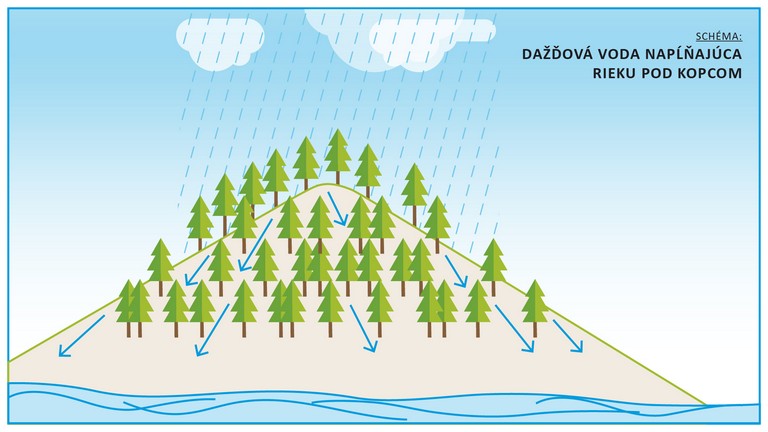
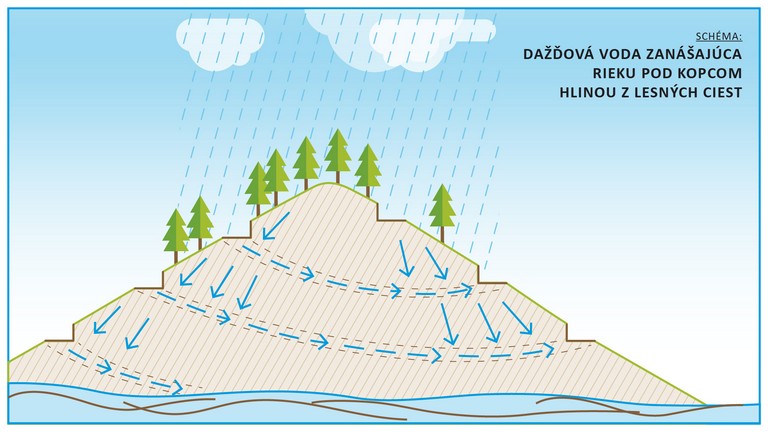
It does not take long for a catastrophe to occur after such major interventions. And floods and droughts are not the only form it can come in.
What is happening in forests when it rains?
Tractors and other machines hauling timber along forest roads and logging tracks leave very deep furrows and rainwater runs along these ditches into rivers with great speed.
Compressed soil – soil, in which pores (canals allowing water to flow to the roots of plants, sources of streams and groundwater) cease to exist under pressure.
In other words:
If we squeeze the pores in soil, water cannot soak into the ground.
Of we break the pores, water flows out.
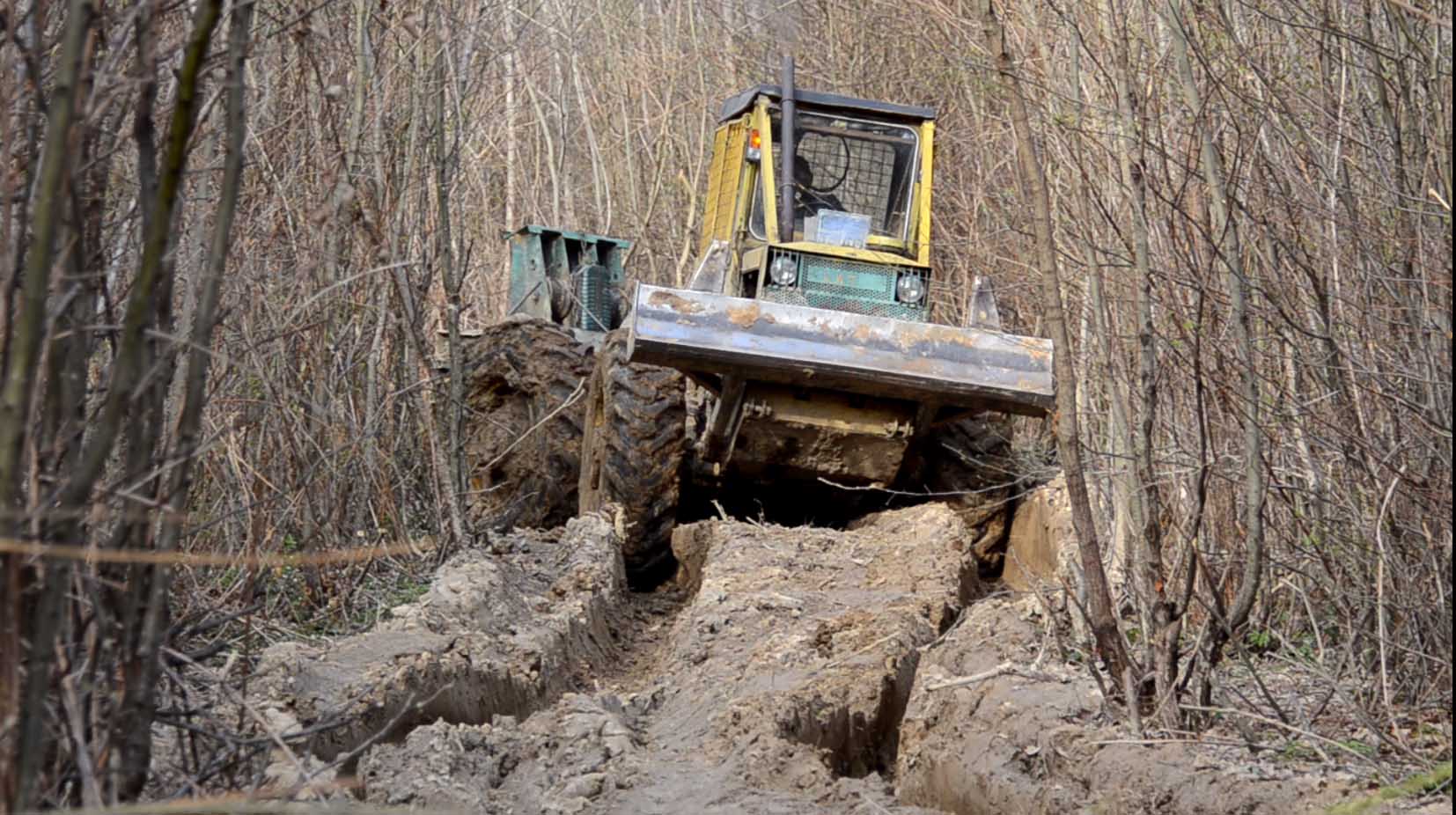

Water keeps on washing out of these compressed surfaces which are unable to absorb any water. Continuous washing out erodes the soil, turning it to stone. Thus, we are losing water as well as fertile soil.
Such devastated forest soil no longer fulfils the role of a logging track, which means that a new one is built only a few meters away from this eroded road ...
We have an abundance of pictures taken at devastated forest roads – but it is also worth to publicize the following material, too:
Nature Conservation Area Jesenníky, Czech Republic
Author of the pictures and video: Martin Míček, o.s. Přátelé Jeseníků - SOJKA
Until 1980s, majority of European countries used the same methods to cultivate agricultural land.
Harvests were followed by deep ploughing and the soil was prepared for autumn and spring sowing. Machines only rarely went on the sowed areas during vegetation seasons, thanks to which rainwater was able to soak into the uncompressed soil.
In the last 30 years, however, compressing of agricultural soil grew severalfold thanks to the new technologies and efforts to minimise agricultural costs.
Compressing cycle




In springs and autumns, the soil is prepared for 10 – 18 cm deep sowing. Thus, crops are sown only in a thin upper layer with a thick layer of compressed soil underneath it.
The first time when tractors compress the soil is during the actual sowing. Later, they return to the fields to spray the crops and fertilise them and the already compressed layer gets compressed even more.
The rainwater which falls on such field soaks the top – cultivated – layer of soil, yet the compressed layer underneath retains only a minimum amount of water. The remaining water runs off to lower areas, taking along fertile soil, too.




After crops sprout, machines are back to the fields both in springs and in autumns. We start with fertilizing and the compressing cycle goes on...
When it rains, the situation happening after sowing occurs again, yet this time water runs off from a much larger area. The water which does not soak into the ground in hilly landscape immediately runs off to the nearest canal or brook. In the lowlands, the water runs off quickly along the furrows into canals and via rivers into the oceans. Few hours after the rain, canals and brooks are empty again.
Even though some of the water forms lakes in the lowest parts of the fields and it can look like the soil is soaked through, the truth is that the underlying compressed layer of soil does not let the water through.
As soon as the crops are 30 cm high, the entire fertilising and compressing process takes place once more.
Muddy water keeps on flowing off of the fields washing up arable land. On the fields with greater inclination it happens frequently that clear water that is running off as the arable land located on the Earth’s surface after the agricultural activities has already been washed off into the dams and oceans. Fields become rocky and, consequently, less fertile.
The process of spraying and sprinkling and of massive compressing of soil continues as long as the crops are growing. And then comes the harvest. As a result of all this, some fields are no longer able to absorb water areally after autumn harvests.
Fields like these were one of the major causes of 2014 floods in the United Kingdom.
Causes of floods in Egland in 2014
Measurements on agricultural land
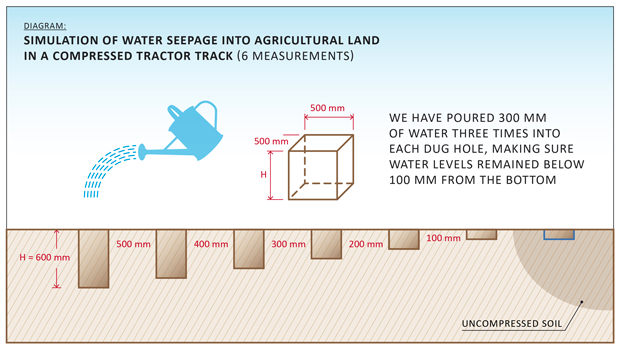
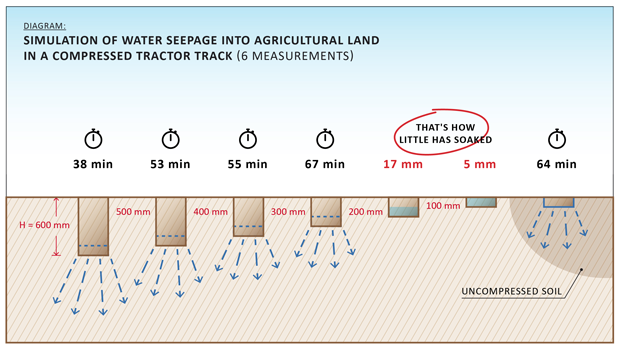
We have carried out a set of water seepage measurements on agricultural land after the crops have been harvested.
First, we have simulated the 100 mm rainfall on a 10m2 large plot of arable land which had been ploughed 30 cm deep, adjusting the speed of the rainfall so that the water gradually soaked into the pores above the ploughed part instead of running off of the plot. The simulated rain lasted for 2 hours and 35 minutes.
We have dug six 60, 50, 40, 30, 20 and 10 cm deep holes on several fields and especially in tractor tracks, and one additional 10 cm deep hole at a plot of uncompressed soil.
We have simulated the 300 mm rainfall in each of these holes, making sure that the level of water in the holes did not exceed 10 cm from the bottom of the holes at any given moment.
Water in the 60, 50 and 40 cm deep holes soaked fastest.
Water in the 30 cm deep hole and in the 10 cm hole at the uncompressed soil took roughly the same time to soak. However, the 20 cm hole was able to retain only 17 mm of water in 3 hours. (zdôrazniť pri čítaní)
Moreover, the compressed 10 cm hole retained only as little as 5 mm of water in 3 hours.
Hence, it can be claimed that a compressed soil layer prevents rainwater from soaking into the ground.
We have also carried out comparative measurements on heavy and mid-heavy soils. Even though these soils took longer to drain the water, they have absorbed it in the end. They have absorbed 5 to 20 mm of water in one day, which exceeds average daily precipitation levels in the given location severalfold.
Causes of floods
- New forest roads grow in numbers daily. As do the side ditches which swiftly drain the rainwater into the rivers below.
- Additionally, side ditches are added to the existing forest roads where they were originally not designed.
- Logging tracks used for timber hauling by tractors turn into wide trenches that also drain rainwater into the ditches by the forest roads and ultimately into the rivers.



